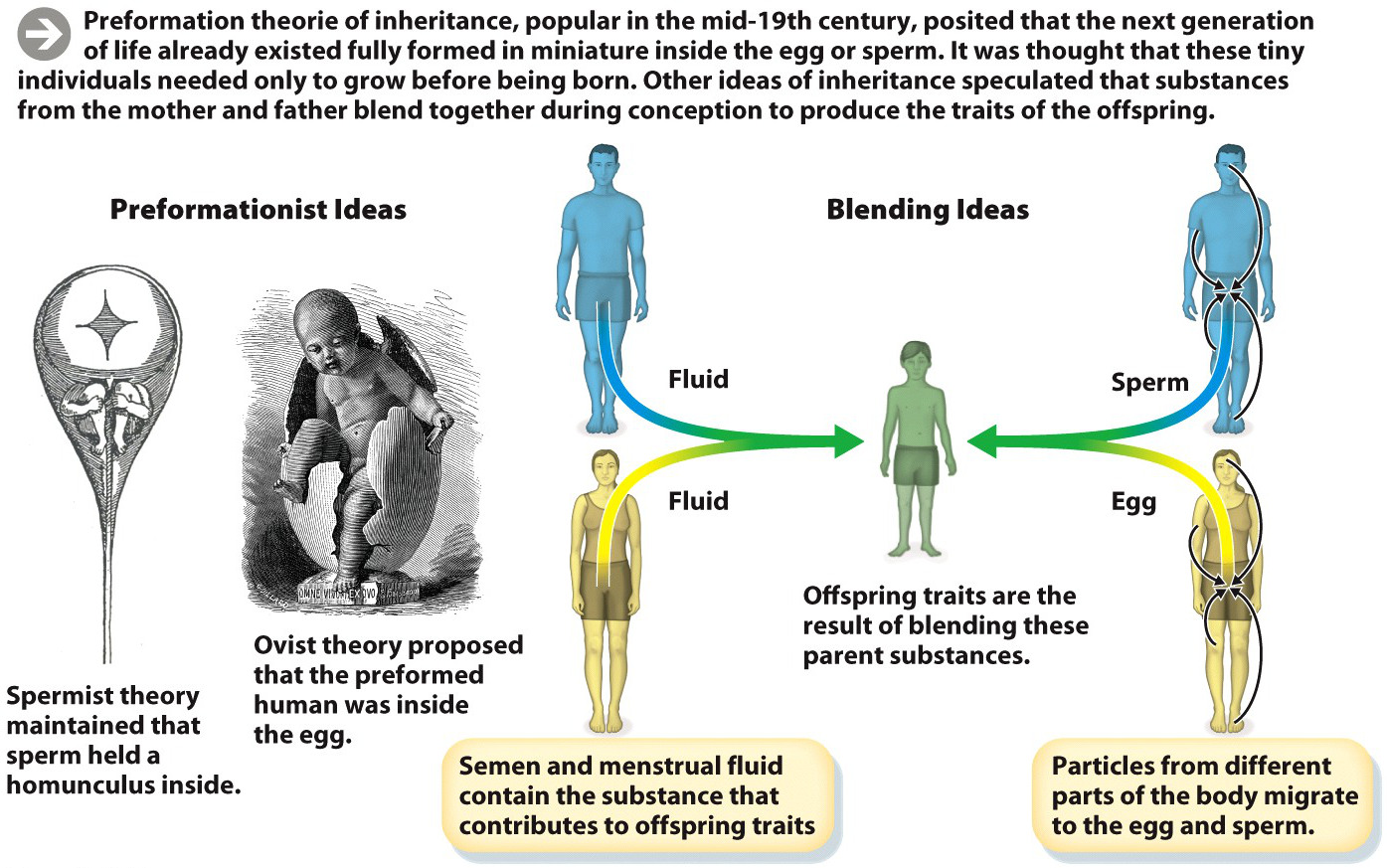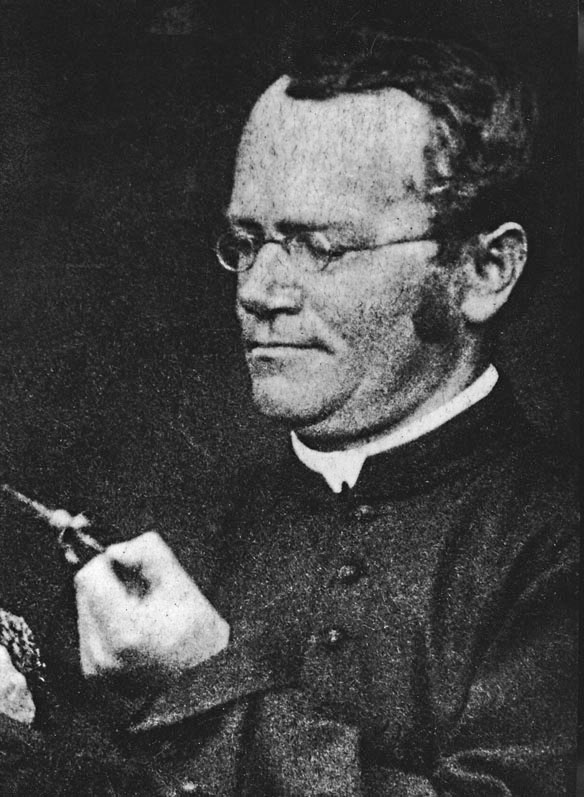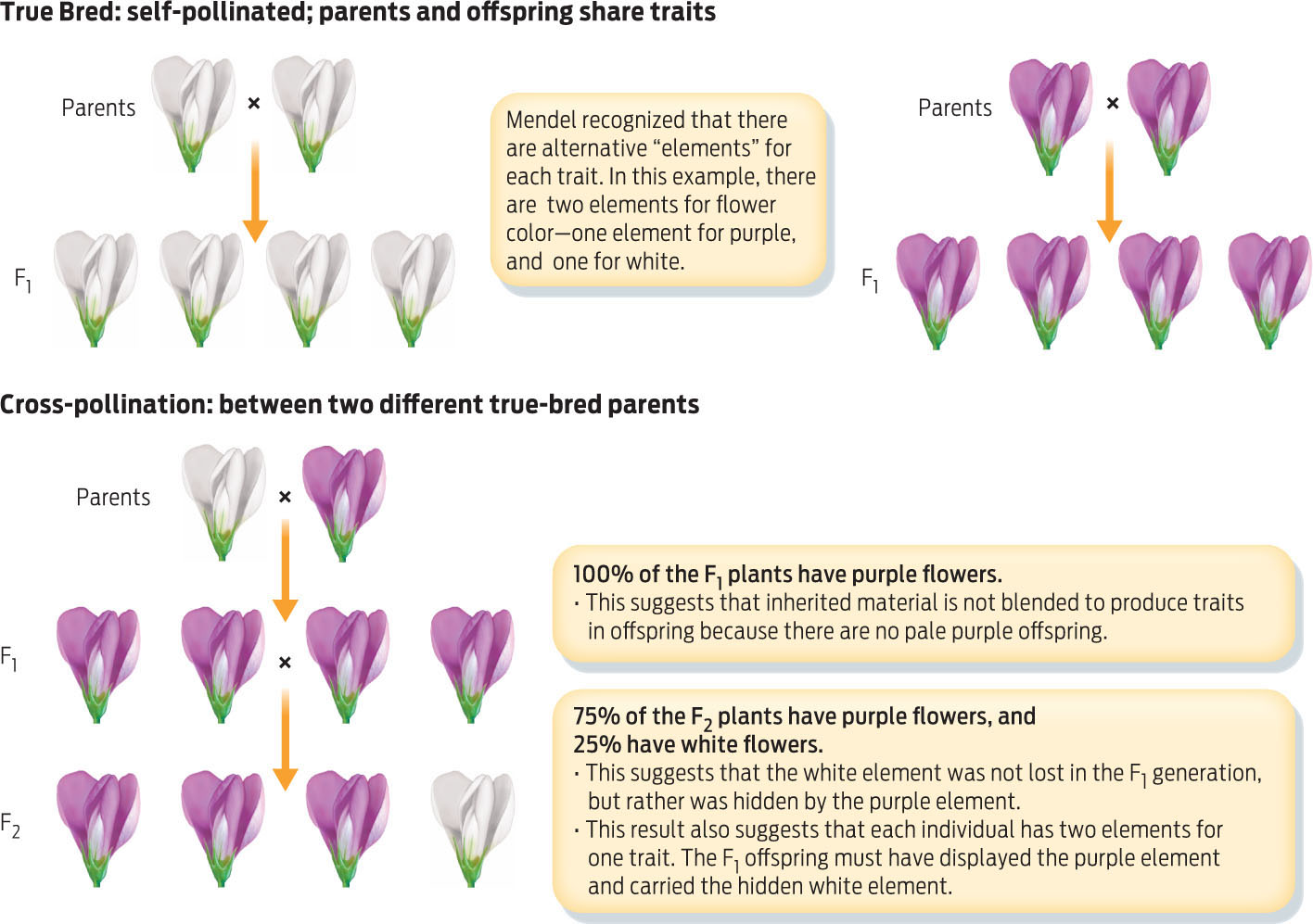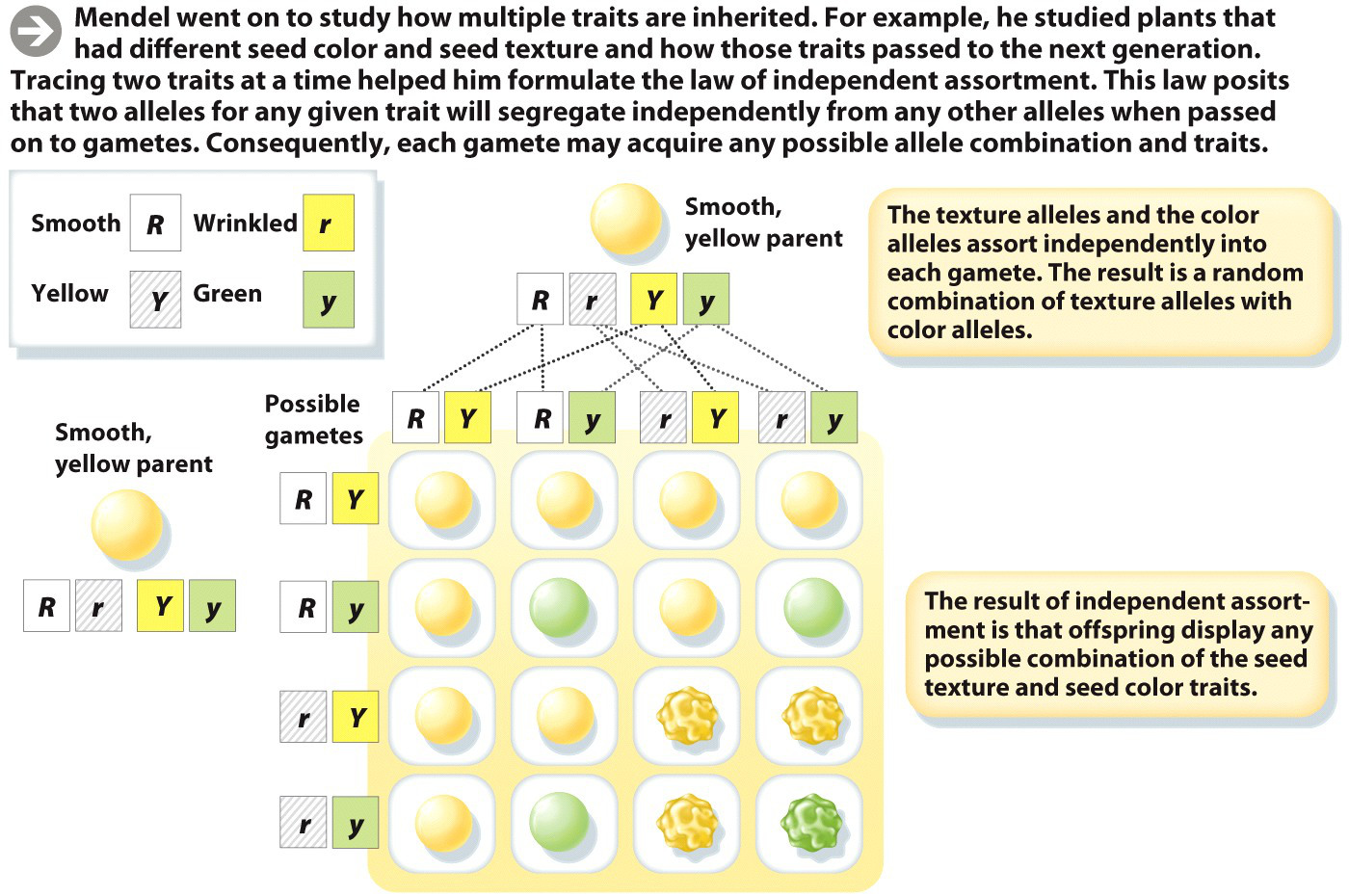248

Mendel provided a new explanation for heredity, decades before the word “genetics” was coined.
249
DRIVING QUESTIONS
- How was Mendel able to recognize the transmission of alleles before the discovery of DNA?
- What do Mendel’s two laws state about how offspring inherit alleles from their parents?
 REGOR JOHANN MENDEL WAS AN UNLIKELY FATHER OF genetics. He was a melancholy Austrian monk who by all accounts suffered from debilitating test-taking anxiety, failing his teaching exam twice. Mendel nevertheless collected the first research suggesting that each parent passes discrete “elements,” or hereditary particles, to each child that determine specific traits. These elements remain intact and can be passed on indefinitely to future generations without being diluted. Although he couldn’t say at the time what these elements were, Mendel had in fact discovered what came to be called genes. We now know that genes come in pairs, and that they exist in multiple discrete forms we call alleles.
REGOR JOHANN MENDEL WAS AN UNLIKELY FATHER OF genetics. He was a melancholy Austrian monk who by all accounts suffered from debilitating test-taking anxiety, failing his teaching exam twice. Mendel nevertheless collected the first research suggesting that each parent passes discrete “elements,” or hereditary particles, to each child that determine specific traits. These elements remain intact and can be passed on indefinitely to future generations without being diluted. Although he couldn’t say at the time what these elements were, Mendel had in fact discovered what came to be called genes. We now know that genes come in pairs, and that they exist in multiple discrete forms we call alleles.
Many scientists of Mendel’s day–the mid-19th century–believed that parental traits were blended together in offspring, like mixing paint colors. For example, a tall mother and short father would have a son or daughter of medium height, who would then pass on that trait–medium height–to their children. Other scientists clung to the old idea that a sperm or egg contained a miniature adult waiting to be born. But through a series of simple yet elegant experiments conducted in a monastery garden, Mendel provided a new explanation for heredity, decades before the word “genetics” was coined (INFOGRAPHIC M4.1).
250


In 1843, Mendel became a monk at the Augustinian Abbey of St. Thomas in Brünn (now Brno, in the Czech Republic). He studied theology and was ordained a priest in 1847. When he failed his teaching exam (the Augustinians were a teaching order), the abbot at St. Thomas sent Mendel to the University of Vienna to brush up. For 2 years he studied math, physics, zoology, and botany, but once again he flunked the test. The depressing result encouraged him to turn from teaching to research.
Mendel returned to the monastery in 1853, and a year later began researching a topic that had sparked his interest in school: hybrids, the offspring of two different breeds or varieties. Mendel was interested in how hybrids form, and he hoped to explain what he and many others had observed: that physical traits (size, color, etc.) can skip a generation.
251
He began his research by breeding mice but, as Robin Henig wrote in her 2001 book The Monk in the Garden, the local bishop found “toying with the reproduction of animals simply too vulgar an undertaking for a priest.” So Mendel decided to work instead with pea plants, which proved a better model organism anyway. The plants grew quickly, and he could better control their environment and breeding.
Mendel began by choosing specific traits that he could see and study, among them seed shape, seed color, pod shape, pod color, flower color, and stem length. Each of the traits he chose to study appeared in two forms. For example, seed shape was either round or wrinkled; seed color was either green or yellow. Because, as he and others had observed, in several types of organism some traits seemed to disappear in one generation only to show up again in the next, he started his breeding experiments with plants that “bred true”–plants with offspring that carried the same traits as the parents, generation after generation. Only then could he study what happened to particular traits when purebred plants of one variety were mated with purebred, or true-breeding, plants of another variety.

Pea plants can self-pollinate, which means that the pea flower contains both male and female sexual organs and a single plant can fertilize itself to produce offspring. To produce true-breeding plants, Mendel covered pea flowers with a small bag so that he could control fertilization, manually fertilizing plants with their own pollen and preventing pollen from another plant from entering. Once he had established true-breeding plants, he could then set up a cross between two different plants. What would happen if he crossed a true-breeding green-seeded plant with a true-bred plant that produced yellow seeds? Or a purple-flowered plant with a white-flowered plant? For each cross, Mendel painstakingly pollinated individual flowers from the two plants by hand. He also prevented self-pollination by removing the male reproductive parts from the plants to be fertilized.
Mendel noticed that when he bred a true-breeding white-flowering plant with a true-breeding purple-flowering plant, the first generation of offspring (what we now call the F1 generation) all had purple flowers. That the flowers were true purple rather than pale purple suggested that parental traits were not blended, as earlier hypotheses of inheritance would have predicted. But the trait for white flowers did not disappear completely, either. When Mendel randomly selected two F1 purple-flowering plants to breed, he found that on average 1 out of every 4 plants of the second generation of offspring (the F2 generation) had white flowers. Mendel reasoned that a hidden white element must be present in the purple F1 plants. So each F1 plant must have two such elements, one representing purple (the trait that appeared) and the other representing white (the hidden trait) (INFOGRAPHIC M4.2).
252

Mendel studied thousands of pea plant crosses and discovered the basic principles of inheritance.

If these results sound familiar, there’s a good reason for that: they reflect dominant and recessive patterns of inheritance, which we discussed in Chapter 11. Purple flower color is dominant over white, which is recessive. Mendel was the first to gather evidence showing that traits could be inherited in a dominant or recessive fashion, and was in fact the who coined these terms. While earlier scientists had noticed that traits could disappear in one generation and reappear in later generations, Mendel was the first to offer a coherent explanation of why they did.
253
Over 7 years, Mendel studied thousands of pea plant crosses and discovered the basic principles of inheritance. He published his results in 1866.
Today we know that Mendel’s “elements” are alleles of genes, and that genes are located on chromosomes. The principles he discovered have been formalized into two laws. The first of these is Mendel’s law of segregation, which states that for any diploid organism, the two alleles of each gene segregate separately into gametes. That is, every gamete receives only one of the two alleles and the specific allele that any one gamete receives is random (INFOGRAPHIC M4.3).

254
The second law, the law of independent assortment, states that the two alleles of any given gene segregate independently from any two alleles of a second gene. Because of independent assortment, offspring can display any combination of the different traits, rather than inheriting the traits together. We now know this holds true only for genes that are located on different chromosomes, or far enough away from each other to recombine. It was mere happenstance that Mendel chose traits for which the genes assort independently (INFOGRAPHIC M4.4).

Despite Mendel’s groundbreaking research, no one realized the significance of his results at the time–not even Charles Darwin, whose Origin of Species was published in 1859. In 1868, Mendel was elected abbot of St. Thomas and largely shifted his focus from science to monastic life and the administration of the abbey. Although Mendel’s research was cited by other scientists, he didn’t receive much notice until three botanists who were also studying how traits are inherited in plants rediscovered his work 30 years later. While preparing, in 1900, to publish their ideas about inheritance, they looked through the research literature and found that Mendel’s work with pea plants had largely anticipated their own. Mendel was finally recognized as the researcher who had solved a crucial mystery of inheritance many years before.
255
MORE TO EXPLORE
 Henig, R. M. (2001) The Monk in the Garden: The Lost and Found Genius of Gregor Mendel, the Father of Genetics. New York: Mariner Books.
Henig, R. M. (2001) The Monk in the Garden: The Lost and Found Genius of Gregor Mendel, the Father of Genetics. New York: Mariner Books.
 Miko, I. (2008) Gregor Mendel and the principles of inheritance. Nature Education 1(1) http://www.nature.com/scitable/topicpage/gregor-mendel-and-the-principles-of-inheritance-593
Miko, I. (2008) Gregor Mendel and the principles of inheritance. Nature Education 1(1) http://www.nature.com/scitable/topicpage/gregor-mendel-and-the-principles-of-inheritance-593
 Griffiths, A. J. F. et al. (2012) Introduction to Genetic Analysis. New York: W. H. Freeman.
Griffiths, A. J. F. et al. (2012) Introduction to Genetic Analysis. New York: W. H. Freeman.